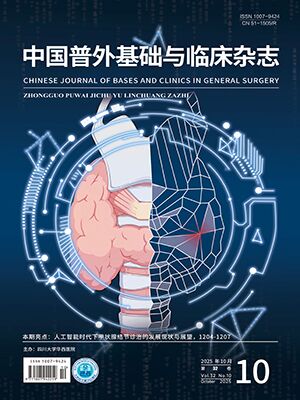| 1. |
中华医学会外科学分会胰腺外科学组. 中国急性胰腺炎诊治指南 (2021). 浙江实用医学, 2021, 26(6): 511-519, 535.
|
| 2. |
Maguire C, Agrawal D, Daley MJ, et al. Rethinking carbapenems: a pharmacokinetic approach for antimicrobial selection in infected necrotizing pancreatitis. Ann Pharmacother, 2021, 55(7): 902-913.
|
| 3. |
Szatmary P, Grammatikopoulos T, Cai W, et al. Acute pancreatitis: diagnosis and treatment. Drugs, 2022, 82(12): 1251-1276.
|
| 4. |
Ouyang G, Pan G, Liu Q, et al. The global, regional, and national burden of pancreatitis in 195 countries and territories, 1990-2017: a systematic analysis for the Global Burden of Disease Study 2017. BMC Med, 2020, 18(1): 388. doi: 10.1186/s12916-020-01859-5.
|
| 5. |
Boxhoorn L, Voermans RP, Bouwense SA, et al. Acute pancreatitis. Lancet, 2020, 396(10252): 726-734.
|
| 6. |
Banks PA, Bollen TL, Dervenis C, et al. Classification of acute pancreatitis-2012: revision of the Atlanta classification and definitions by international consensus. Gut, 2013, 62(1): 102-111.
|
| 7. |
曹锋, 李非, 赵玉沛. 《中国急性胰腺炎诊治指南 (2021) 》解读. 中国实用外科杂志, 2021, 41(7): 758-761.
|
| 8. |
Lee DW, Cho CM. Predicting severity of acute pancreatitis. Medicina (Kaunas), 2022, 58(6): 787. doi: 10.3390/medicina58060787.
|
| 9. |
王誉翔, 许明, 陈钰. sFlt-1、D-乳酸、LDH表达在急性重症胰腺炎合并感染临床诊断的价值研究. 黑龙江医药科学, 2025, 48(1): 114-117.
|
| 10. |
苏阿芳, 蒋晓忠, 张云水, 等. 血清甘油三酯累积暴露水平对急性胰腺炎发病风险的影响. 临床肝胆病杂志, 2024, 40(12): 2492-2498.
|
| 11. |
李宗倍, 安宏超, 吴畏, 等. 血清降钙素原、C反应蛋白、前白蛋白联合检测评估急性胰腺炎病情进展的价值. 大医生, 2025, 10(1): 113-116.
|
| 12. |
韩芳, 赵景, 屈少磊, 等. 红细胞体积分布宽度、血小板平均体积、红细胞平均体积联合降钙素原在急性胰腺炎早期诊断中的临床价值. 实用临床医药杂志, 2024, 28(17): 45-50.
|
| 13. |
Hu JX, Zhao CF, Wang SL, et al. Acute pancreatitis: a review of diagnosis, severity prediction and prognosis assessment from imaging technology, scoring system and artificial intelligence. World J Gastroenterol, 2023, 29(37): 5268-5291.
|
| 14. |
蓝远强, 黄丽珍, 梁敏, 等. 血清学指标和相关评分系统预测及诊断急性胰腺炎严重程度的进展. 现代消化及介入诊疗, 2020, 25(11): 1539-1542.
|
| 15. |
Harshit Kumar A, Singh Griwan M. A comparison of APACHE Ⅱ, BISAP, Ranson’s score and modified CTSI in predicting the severity of acute pancreatitis based on the 2012 revised Atlanta Classification. Gastroenterol Rep (Oxf), 2018, 6(2): 127-131.
|
| 16. |
Wiley MB, Mehrotra K, Bauer J, et al. Acute pancreatitis: current clinical approaches, molecular pathophysiology, and potential therapeutics. Pancreas, 2023, 52(6): e335-e343. doi: 10.1097/MPA.0000000000002259.
|
| 17. |
Mederos MA, Reber HA, Girgis MD. Acute pancreatitis: a review. JAMA, 2021, 325(4): 382-390.
|
| 18. |
王超, 付小萌, 赵鹏飞, 等. BJ-MODS、APACHE Ⅱ、SOFA、Marshall-MODS评分系统对MODS患者病情评估价值的比较. 临床和实验医学杂志, 2013, 12(22): 1868-1873.
|
| 19. |
Zhou H, Mei X, He X, et al. Severity stratification and prognostic prediction of patients with acute pancreatitis at early phase: a retrospective study. Medicine (Baltimore), 2019, 98(16): e15275. doi: 10.1097/MD.0000000000015275.
|
| 20. |
田光芳, 张渊智, 余玉红, 等. 血钙与APACHEⅡ评分评价急性胰腺炎重症倾向的价值分析. 卫生职业教育, 2022, 40(10): 147-149.
|
| 21. |
Stirling AD, Moran NR, Kelly ME, et al. The predictive value of C-reactive protein (CRP) in acute pancreatitis - is interval change in CRP an additional indicator of severity?. HPB (Oxford), 2017, 19(10): 874-880.
|
| 22. |
Viswanathan S, Jain D, Vinayagamoorthi R, et al. Electrocardiogram heart rate as a predictor of severity in acute alcohol-related pancreatitis with alcohol withdrawal syndrome. Cureus, 2020, 12(11): e11737. doi: 10.7759/cureus.11737.
|
| 23. |
Okamoto T, Arashiyama M, Nakamura K, et al. Clinical outcomes in acute pancreatitis with relative bradycardia at fever onset. Medicine (Baltimore), 2021, 100(46): e27901. doi: 10.1097/MD.0000000000027901.
|
| 24. |
Riley RD, Ensor J, Snell KIE, et al. Calculating the sample size required for developing a clinical prediction model. BMJ, 2020, 368: m441. doi: 10.1136/bmj.m441.
|
| 25. |
Baron TH, DiMaio CJ, Wang AY, et al. American Gastroenterological Association clinical practice update: management of pancreatic necrosis. Gastroenterology, 2020, 158(1): 67-75.
|
| 26. |
Li M, Li Q, Yin Q, et al. Evaluation of color doppler ultrasound combined with plasma miR-21 and miR-27a in the diagnosis of breast cancer. Clin Transl Oncol, 2021, 23(4): 709-717.
|
| 27. |
陈鑫龙, 叶凯, 周文策. 人工智能在胰腺疾病新型诊疗模式中的应用及进展. 中国医学物理学杂志, 2022, 39(8): 1049-1056.
|




